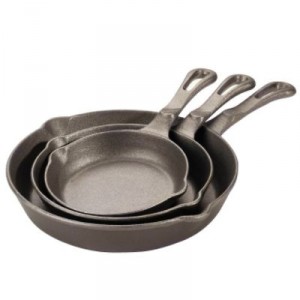Not long ago some friends gave us a set of three cast iron skillets as they were lightening their load during a move. The skillets were used, and encrusted with… something. I know people who use cast iron and they tend to praise it highly, so it seemed like a worthy exercise to see if this stuff could be restored.

A quick internet search gave me some idea of what needed to be done. First, the pans needed to have the residue removed, and the surface re-seasoned. Cast iron cookware has a non-stick surface formed by tiny droplets of oil that reside in the pores of the cast iron. “Seasoning” is the process by which you create this surface. This is also why you never clean a seasoned with soap or detergent; it will remove the oil and require you to re-season the pan.
I started by putting the pans in the oven and running the self-cleaning cycle. I figured what removed mostly organic crud from the inside of the oven would also work on the pans and it did. They came out remarkably clean except for a fine dusting of rust. One web site I looked at said that using a slurry of sea salt and vegetable oil was a good way to remove rust. I poured in about a table spoon of oil and an equal amount of salt together and went to work with a paper towel. I was amazed at how well this worked. The rust came off literally in just a few strokes with gentle pressure. Next I washed the pans in hot soapy water and let them dry thoroughly. One might even use the oven at 150 degrees with the door slightly ajar to do this.
Now it was time to re-season the pans. I confess I was apprehensive about this. All kinds of oils are said to work, but most say that lard is best. A friend of mine has also mentioned that flax seed oil makes a good, hard finish, but I haven’t had a chance to try this. I rubbed all the surfaces of the skillets with a light layer of lard and placed them back in the oven upside down and baked them at 350 degrees for about 2-3 hours. Most recommend you do this process at least twice, which I did.
Did it work? Well, most of the time food does not stick, but there are some caveats. Cast iron cookware does not really require using very high heat (my cooking habits have favored cooking on with the burners set on “11”). Medium to medium high is quite enough. Too much heat and the surface starts sticking. Also, if you are frying it’s best to let the pan get hot before adding butter or oil. Otherwise you can get sticking.
So while they require you to change a few things about how you cook, these changes are, I think, mostly for the better. Cast iron demands that you take your time with cooking. By cooking at slightly lower temperatures, flavors seem to mix better. It spreads heat beautifully and when you’re done, most of the time you can just wipe it clean with a paper towel or rinse with a little warm (not hot) water. If some scrubbing is needed, a little salt will do the trick. But no soap, no detergent. Otherwise you’ll have to re-season the pans.
If you want to try using cast iron, don’t bother buying it new and paying full price. It can be expensive. You can find good pieces at thrift stores, garage sales, rummage sales and flea markets. If it is in need of some restoration you can get it cheap and restore it to prime condition.


Sheldon, thanks for posting this, I have a cast iron pan that has some rust so I am going to try the salt & oil trick, or have Dan do it if it needs muscle power. Regarding the flax oil, I have been told that it gets rancid when heated, so it probably is best to stick to other oils.
Love your new blog!
Happy New Year.
We have a cast-iron frying pan and Dutch oven, both of which I love. I use hot water and a bit of detergent to clean them, and it doesn’t seem to hurt the seasoned-ness of the pans. (Neither soap nor hot water stays on the surface for very long, though; maybe that’s the trick.)